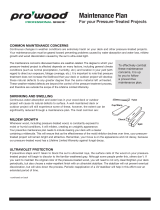Page is loading ...

Visit Lowes.com for more information.
LOWE’S and Gable Mansard Design are registered trademarks of LF, LLC. © 2016
Available at
Hi-bor
®
Borate Pressure Treated Wood Product Information Guide
Hi-bor
®
Borate Pressure Treated Wood Products:
• For use in above ground weather protected structural framing in residential and
commercial projects, such as residential dwellings, industrial buildings, or any
application requiring wood protected against termites, carpenter ants, and fungal
decay, including dry rot.
• Hi-bor Borate Pressure Treated Wood Products are backed by a 20-year limited
warranty (See warranty for details.).
• Pressure treated with an EPA registered borate wood preservative for protection
against termites, carpenter ants, and fungal decay.
• Hi-bor Borate Pressure Treated Lumber is recommended for sill plate, joists, studs, roof trusses, blocking, rafters,
beams, and other framing applications.
• Hi-bor Borate Pressure Treated Plywood is recommended for wall sheathing, roof sheathing, and suboors, where
not exposed to wetting conditions.
Materials
• Hi-bor Borate Pressure Treated Wood is treated with Disodium Octaborate Tetrahydrate (DOT).
• Hi-bor Borate Pressure Treated Wood is accepted by Hawaii building codes, major model building codes, and it is
supported by the ICC Legacy Report #NER-648.
Workability
• As with untreated wood, Hi-bor Borate Pressure Treated Wood may be sawn, drilled, or routed with standard
woodworking equipment.
• Hi-bor Borate Pressure Treated Lumber is also recommended for fascia, trim, and miscellaneous wood
applications, when properly protected from the weather (refer to limitations).
• Products may be fastened with standard (common) nails and screws. Check local building codes which may vary
in requirements.
Limitations
• Hi-bor Borate Pressure Treated Wood is intended to be used for framing and applications where the wood is not in
direct contact with the ground and is continuously protected from liquid water. Normal exposure to weather during
ordinary installation will not adversely affect the performance of the product.
• Hi-bor Borate Pressure Treated Wood Products should not be used for outdoor structures exposed to weathering
and rain.
• Facia and other exposed applications must be protected with primer and at least two coats of paint. Material must
be allowed to dry before painting.
Technical Information
• All products bear a permanent ink stamp or end tag carrying the Hi-bor
trademark, a quality mark of an approved third party inspection agency,
and the name of the treating company that produced the treated products.
• For further technical information and Material Safety Data Sheets, contact
Koppers Performance Chemicals Inc. as listed under Warranty and Technical Support.
Important Information
• Do not burn preserved wood.
• Job site storage - intended for interior use only- store off the ground & cover to protect from water and allow
for ventilation.
• Wear a dust mask and goggles when cutting or sanding wood.
• Wear gloves when working with wood.
• Wear gloves when working with wood.
• Some preservative may migrate from the treated wood into soil/water or may dislodge from the treated wood
surface upon contact with skin. Wash exposed skin areas thoroughly.
• All sawdust and construction debris should be cleaned up and disposed of after construction.
• Wash work clothes separately from other household clothing before reuse.
• Preserved wood should not be used where it may come into direct or indirect contact with drinking water,
except for uses involving incidental contact such as fresh water docks and bridges.
• Do not use preserved wood under circumstances where the preservative may become a component of food,
animal feed, or beehives.
• Do not use preserved wood as mulch.
• Only preserved wood that is visibly clean and free of surface residue should be used.
• If the wood is to be used in an interior application and becomes wet during construction, it should be allowed
to dry before being covered or enclosed.
• Disposal Recommendations: Preserved wood may be disposed of in landlls or burned in commercial or
industrial incinerators or boilers in accordance with federal, state, and local regulations.
• If you desire to apply a paint, stain, clear water repellent, or other nish to your preservative treated wood, we
recommend following the manufacturer’s instructions and label of the nishing product. Before you start, we
recommend you apply the nishing product to a small exposed test area before nishing the entire project to
insure it provides the intended result before proceeding.
• Projects should be designed and installed in accordance with federal, state, and local building codes and
ordinances governing construction in your area and in accordance with the National Design Specications
(NDS) and the Wood Handbook.
• Mold growth can and does occur on the surface of many products, including untreated and treated wood,
during prolonged surface exposure to excessive moisture conditions. To remove mold from the treated wood
surface, wood should be allowed to dry. Typically, mild soap and water can be used to remove remaining
surface mold. For more information visit www.epa.gov
• Use fasteners and hardware that are in compliance with the manufacturer’s recommendations
and the building codes for their intended use.
/







